“In our hearts, we’ve been burned.”
A spry woman stands before a large, carpeted hotel conference room, her sturdy, Midwestern voice clipping along without need of a microphone as the room murmurs in agreement. She speaks emphatically, her gaze swaying back and forth over the dozens of participants like a fan forever saying no. “Sometimes we get our clown stuff on and think everybody loves us and everything is great!” She pantomimes a peppy little dance with a big, toothy smile. Abruptly, she drops the act, her grin slumping into a scowl, shoulders following suit. “Wake up, clown.”
The group is small, around two dozen people or so, most of whom are members of the AARP generation, but engaged, keenly focused on her, sitting quietly in their stackable chairs, raising their hands as necessary and nodding along with her message. A few are taking notes. The woman behind me smells strongly of cotton candy and it makes my mouth water in that hot, fast way that happens when you're about to be carsick. It’s 9:00 on a cold March morning, day five of the 31st annual World Clown Association Convention in a suburban Chicago hotel, and Tricia Manuel, better known as Priscilla Mooseburger, is commanding the room.
The branch of clowning represented here is the one with the big shoes and balloon tricks, corporate-event clowning and gospel clowning. There are the caring clowns, who aim to bring joy to the sick, and clowns who take church mission trips to foreign countries. Of this wholesome, whiteface empire, one of the few titans at the top is Priscilla Mooseburger. A former Ringling Brothers and Barnum & Bailey circus clown and costume designer, the current occupation listed on her LinkedIn profile is “Queen of Clowns” at Priscilla Mooseburger Originals. She’s been running her eponymous clown arts camp since 1994, the website for which invites you to "COME TO MOOSEBURGER YOU’LL FEEL FUNNY."
Our complicated relationship with clowns spans everything from the circus to the sex dungeon, from Saturday morning Bozo to Tim Curry peering up from the storm drain, from Patch Adams to Insane Clown Posse, not to mention the ubiquity of that flame-haired, greasepaint visage, the placidly smiling face of what is surely the 20th-century Ozymandias: Ronald McDonald. Every person I told about my plan to attend the clown convention voiced concern for my well-being.
One woman in particular keeps tripping my peripheries with her floppy bucket hat and the way it shudders limply atop her head. Later, when she removes it, I realize that her orange highlighter locks are not, in fact, a wig, but a hue she coaxed nature into.
This seminar, called “Posing for Pictures and Working with the Media,” is for the most part a simmering rally for strategy and solidarity in the face of the current clown PR crisis. Of course, there’s the usual scary-clown trope to deal with, like the recent separate attempts by filmmakers to drum up some publicity by donning clown garb and standing ominously along roadsides and construction sites, last year in Northampton, U.K., and more recently in Staten Island.
But there’s an additional tension this year: Just weeks prior, the New York Daily News reported that America might be facing a clown shortage. Citing decreased membership rates in the country’s largest trade organizations — Clowns of America International (CAI) and the World Clown Association (WCA) — the article painted clowning as the loser in a war of attrition, but nonetheless steadily committed to the fight. CAI President Glen Kohlberger claimed membership numbers are dropping because “[t]he older clowns are passing away.” Compounding this, the reasoning goes, is that interest in clowning is waning: Kids just aren’t joining up like they used to. But despite making clowns sound like a critically endangered species no one is rushing to save, the article also mentioned the intense competition for clowning jobs with Ringling Brothers and Barnum & Bailey Circus and higher audience expectations necessitating a higher quality of clown. Higher standards are not the usual by-product of a surfeit of talent.
Mooseburger opens the floor for a listing of scary clowns — a naming of the enemy, so to speak. Voices call out around the room, and I consider joining in when no one says John Wayne Gacy, but think better of it. A man yells sharply, “The Joker from Batman!” and the room buzzes in agreement like a human vuvuzela. But in spite of how grim things look out there, Mooseburger preaches the promotion of positive clowning with corn-fed sensibility.
She mocks the shock jocks who call her for interviews and appearances: “Really?” she spits out with a distasteful laugh, her head bobbing up and down like a lovesick cockatiel. “You’re interested in the art of clowning?” Later, she notes, somewhat menacingly, to never take work as a blood-soaked haunted house clown, implying that no real clown would ever participate in the denigration of such a good and wholesome art form.
Mooseburger calls for volunteers to try couples poses, positioning the tall man behind her, his shoulders back and hands on hips, before — at a suitably chaste distance — she bends over directly in front of him and props herself up with hands on squatting knees. Leaning forward with a big, toothy smile, Mooseburger says, “What used to be OK is not.”
What follows is a series of poses, punctuated by rapid-fire comments about Miley Cyrus and our “corrupt society.” “Don’t think that just because you’re a woman that you get a free pass, not in this society,” she warns, referring to how easy it is to be photographed looking accidentally inappropriate. Periodically, she stops the exercise and bellows, “Both hands showing at aaaaall times!” Then the fire alarm rings.
The space is suddenly too small for all the people rushing out of it. The bottleneck into the stairwell has a faint whiff of Black Friday desperation, and clowns collide with me and my bag as I stagger like a drunkard to keep myself conducive to upright and controlled motion. The stairway is filled with the elderly wearing complicated hobby costumes. I make it out unscathed and the fire alarm turns out to be something minor. In the aftermath, clowns mill about the hall. I watch other hotel guests try not to stare, I try not to stare, employees try not to stare, but everyone is staring.
In one regard, the convention feels like any other: like-minded people who share an interest in something, people who love it in a manner much deeper than your average bystander, who know it in incredible detail. But amid the camaraderie, in the spaces between the cliques, the atmosphere is softly bristled. After the seminar, the conversations taking place among the stragglers return to the shortage. “If the clown shortage is real, I’d be having an easier time gettin’ work!”
In spite of the current backlash, clowns are still more than an easy punch line or sight gag. Floyd Mayweather Jr. — the highest-paid athlete in the world — hired a clown procession to lead him into the ring for his win over Marco Maidana. Juggalos have made clowns a symbol of empowerment. A video of Puddles, a tall, sad clown, singing Lorde has more than 8 million views on YouTube. Julia Louis-Dreyfus had clown sex in a GQ spread. (OK, maybe that was a sight gag.) The interesting thing hidden in the guarded humor of this convention is not some piecemeal insight into why people dislike a comedic figure — it’s why, all of this sentiment to the contrary, the clown persists as a cultural icon, revered or feared. There seems to be a perverse and abiding fascination, if even a morbid one. But why? I mean, you clicked on this, right?
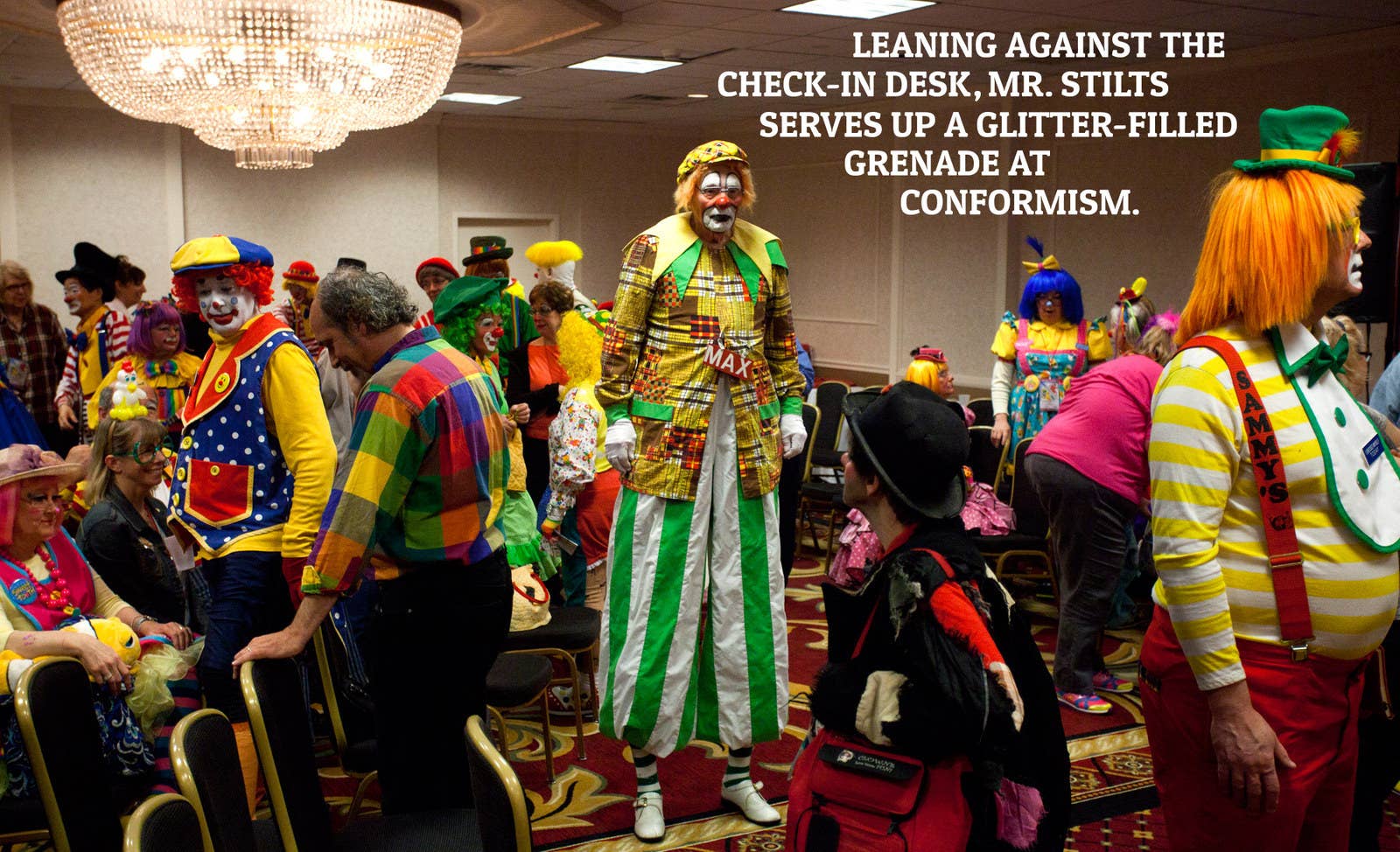
The hotel lobby is decorated to theme — a nice touch, but conspicuous. The balloon art displayed at the front desk isn’t just festive; it’s a signal to the non-clown guests. The inflated, latex animal serves as a polite catalyst for inquiry, such that a hospitable warning might be offered.
I am not afraid of clowns. But there’s something that happens when you walk into the forgettable bathroom of a hotel lobby and meet a fully made-up clown standing by the sink, reflection staring back at you with the Kubrickian blankness of a greasepaint grimace.
I almost wet my pants.
Media seminar fresh in my head, I choke the gasp in my throat and try to smile. While I am going for “warm and effusive,” I’m sure my face is more a pained amalgamation of terror. I can only hope that she thinks I'm trying to be polite. I’m sure she gets it all the time.
But. There are reasons people can find clowns to be so unsettling. That makeup: white face; huge, red mouth; drawn-on smile; eyebrows that kiss the hairline. “When it's up close, it's the visual equivalent of being screamed at,” explains Jaron Aviv Hollander, the co-founder and artistic director of the Kinetic Arts Center in Oakland. And it’s all the big top’s fault: When a clown is standing in one of three or more rings and playing to a huge crowd, the audience needs to be able to read familiar facial landmarks in order to get the bit.
Hollander, a Cirque du Soleil alum and co-creator of “The Submarine Show,” a two-man mime act that played Edinburgh Fringe Festival, says there’s a very practical reason behind some of our collective clown discomfort. “Stephen King didn’t make that scary,” he says, referring to the traditional makeup worn by Pennywise the Clown in King’s It. “He found something that was scary and wrote about it,” adding that the inherent cognitive dissonance between applied makeup and natural expression adds to the creepiness factor. “The makeup is just a mask, and when you do, like, a big smile or a frown or something, that’s an emotion, and you can see the lie.” He is, however, quick to note that within the proper context, like a circus, the makeup is effective. “There are brilliant clowns who do that, and when they're in [their element], they're not going to be scary.”
The hotel restaurant is filled with clowns eating lunch and tapping listlessly on their phones. I watch passersby pose for pictures with an older gentleman on stilts dressed in full clown regalia. Leaning against the check-in desk, Mr. Stilts serves up a glitter-filled grenade at conformism. By embodying a living, breathing icebreaker, talking to people as they wrap their arms around him for pictures, he’s not so quietly breaking the taboo of how you’re supposed to interact with strangers.
Being at the convention involves a dizzying array of stimuli, seamlessly flip-flopping between nice and creepy. (Hotel guests taking pictures and squealing with glee? Nice. Sad clown sitting alone, smoking in his car in the parking lot? Creepy.) Lisa Hinshaw of Illinois got into clowning when her daughter was diagnosed with Asperger’s syndrome, as a way to reach her and connect emotionally. The same way early Disney characters were designed to emote distillations of human emotions so pure that dialogue was superfluous, clowning, too, is in the business of entertainment that doesn’t need words to first be understood. The clowning helped this woman reach her daughter, and she's been doing it ever since.
One of the vacant conference rooms is a standard bare, carpeted cube, filled with banquet tables and white tablecloths and squat, brown, hotel trash cans, perfectly forgettable, save for a jack-in-the-box costume with a life-size clown dummy spilling over the top, mid-spring. The box is big enough for one adult or several children to hide under, the jack’s face contorted into an open maw of gruesome surprise or delighted sadism. The clown has the empty stare of a corpse, and there’s no way to know if there’s someone inside the box right now, waiting to jump out. It’s clown inception, a clown within a clown, possibly within another clown. I cannot stay in the room with it.
I go downstairs and peek in at the clown camp, which right now appears to be a dozen or so small children playing with circus toys in a room and having the most joyous kind of nondescript fun. But I don’t see many teenagers or evidence of a next generation poised to carry on these traditions from aging professionals; in fact, the seminar on mentoring up-and-comers is mostly focused on teaching tips and theater games.
Like most conventions, this one is highly specific. If clowning were Halloween, the WCA Convention would be a megachurch Halloween-alternative party. And while maybe the church party with caramel popcorn and novelty Bibles might have a hard time filling the place year after year, to many people it’s a cherished tradition and a haven inside a corrupt holiday. Still, I’d be remiss if I didn’t remind that these wholesome circus clowns are just one niche in a universe of clowning that shows no signs of truly disappearing. And it’s not just senior citizens getting their silly on.
It’s the friend of mine who has his toddler in circus arts classes. Or the sportswriter I like so much who went to a prestigious clown school in France. Or my favorite bartender, who used to busk on the street in full clown regalia, playing a child’s piano and sitting on a tiny stool. Or my dear friend of over a decade who only recently told me about his childhood experience with clown camp. Or...me, who played the canine clown role of Blue the dog in a North American tour of Blue’s Clues Live! Ask around, and you’ll probably be surprised by how many clowns you know.
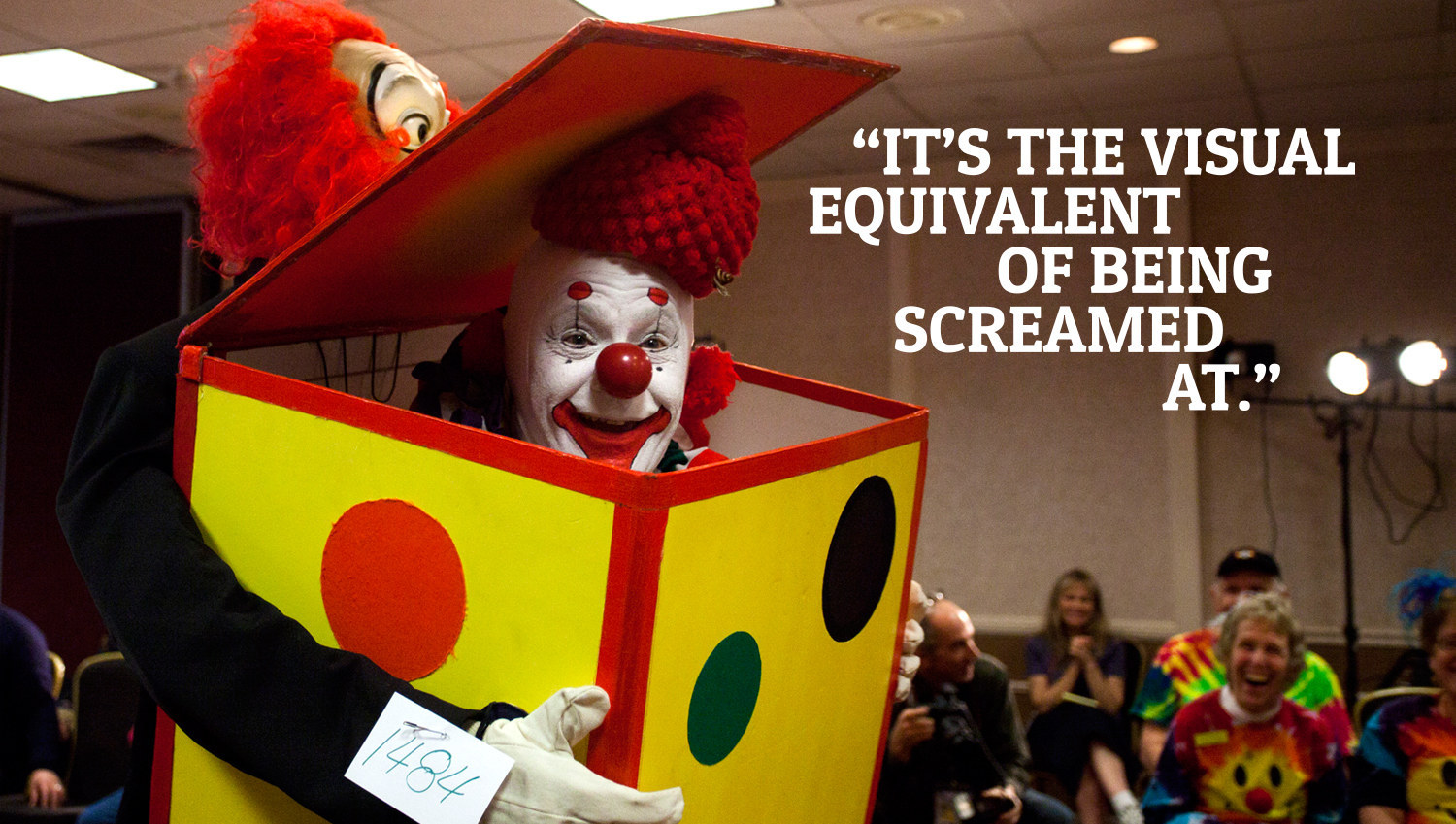
So, when did the clown emerge in our history? “I don’t know,” Hollander says, laughing. “I think that it goes back to a point when cavemen are sitting around a campfire, making fart jokes.”
He’s not wrong. Across the ages, from court jesters to fools on stage, clowns have used physical comedy to do important work. By acknowledging taboos and doing the wrong thing the right way (like falling in love with an inanimate object) or the right thing the wrong way (fishing in a lobster tank), or by just outright flying past the fuzzy, culturally sanctioned limits of propriety, clowns function as society’s pressure valve.
Aristotle says in Poetics that comedy and satire originated with phallika — ritual clowning in the form of a penis parade. These parades were a common feature of the cult of Dionysus, filled with obscenities, verbal abuse, and, of course, penises.

Ritual clowns in the Zuni tribe cure illness through dance, speaking truth to power with sharp-edged paradoxes of current events. They also eat things like urine, feces, pebbles, and ash to prove the superiority of their own stomachs. (And, I imagine, to provide an emetic for those in need.)
Americans tend to think primarily of circus clowns and children’s entertainment. Greasepaint, red nose, giant shoes, loud wig, that sort of thing. But clowning as an art form is — and for a long time has been — a way that humans turn our fears and inadequacies into the foundation of community and intimacy. It’s hard not to feel like we’ve lost something weird and wonderful by making clowns into scary, carnivalesque villains.
“The clown perhaps is this important figure that allows us to see ourselves in our naked, humiliating glory and to be able to laugh at ourselves,” says Quinn Bauriedel, co-founder and co-artistic director of the Obie Award-winning Pig Iron Theatre and director of the Pig Iron School for Advanced Performance Training. “The clown is kind of helping us admit to ourselves that we are fundamentally stupid and perhaps poetically stupid,” adding that he uses that word to mean “something wonderful, not something horrible.”
“When someone trips and falls, we look and we laugh because secretly we're like, I'm glad that person tripped and fell and it wasn't me.” He confesses that he fell down yesterday, and that yes, someone laughed at him.
Which is, of course, the beauty of the clown. “This little red nose helps us to seek out our own idiosyncrasies and neuroses and foibles and begin to share those in public so that other people can laugh at them, form community, and realize that, in some fundamental ways, we all fail.”
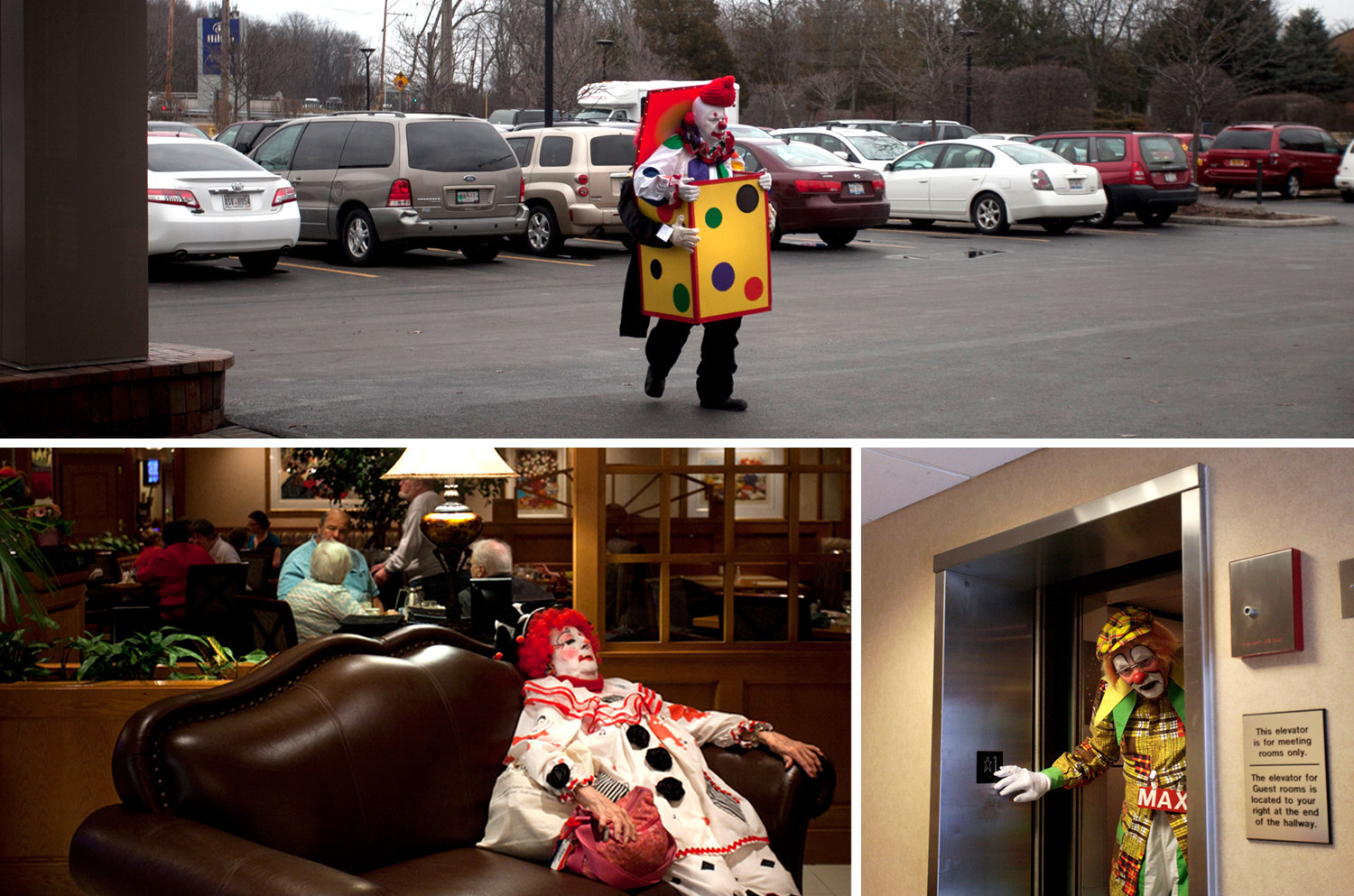
There’s one equine in the World Clown Association parade and competition, a petite woman in cowgirl clown gear, encased from the waist down in an inflated horse costume. The head and forelimbs of the chestnut steed sprout limply from her waist. Watching her mill about as organizers struggle to get the clown contestants into the proper numerical order, the costume seems depressing, the horse’s head lolling about in a drunken oblivion.
It could be an homage to Sir Philip Astley, a late 18th century trick rider who realized that more people came to his shows when the riders fell inside his 42-foot ring. Failure was entertaining. And that’s how, in the Waterloo area of London, Astley became the father of the standard circus ring size and, really, of the modern circus. (His wife was no slouch either, best known for galloping into the ring, standing atop her horse, with a swarm of bees around her hands like a hymenopteran muff.)
There is chaos in the hallway, the mix of languages and general organizational confusion writ large in the cacophony of attention-seeking garb. A man shuffles by me, sandwiched between two blankets stretched over a wire frame, his face atop a plastic infant body. A woman dressed as some kind of bondage gypsy clown, complete with a belt full of animal pelts, a flask, and what appears to be S&M paraphernalia, clutches a larger-than-life book, rocking slightly on her heels as she waits for her turn. Later, when she walks the carpet in front of the judging table, carefully beginning and ending her timed bit by the masking-tape marks, she reveals herself a palm reader — or rather, palm red-er, placing pieces of red paper into the judges’ hands. That's the joke.
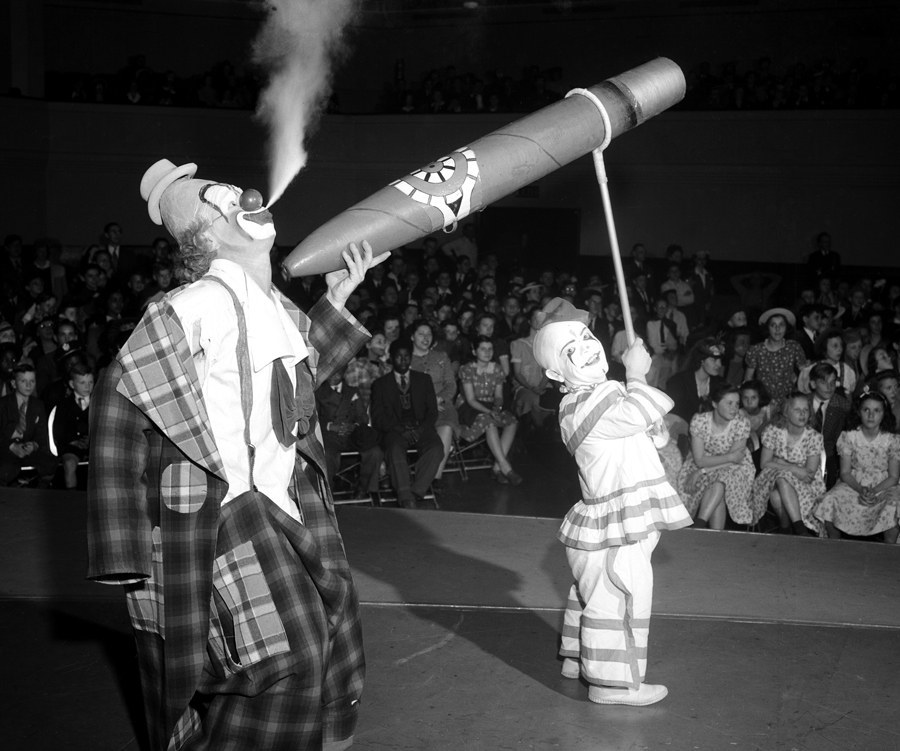
Amid the visual noise, I’m drawn to large, rectangular man dressed as a lunch lady, complete with panty hose carefully dotted with inch-long cords of cartoonish stubble. Pressed up against the wall, hands resting on a pushcart of unappealing fake foods, he’s hopelessly in the way. It’s not the lunch lady gag itself that catches my eye, which could have read cruelly. Rather, it’s that he seemed to embody a lunch lady without mocking her. Watching him prepare to parade across the conference room, there is something remarkably kind and inviting about this.

A woman in one of the first few rows is making a muffled thumping sound, bashing her shoulder blades hard against an economically upholstered hotel conference-room chair as she rocks back and forth under the weight of restraint. She clamps a hand over her mouth, the contortions of her grimace crinkling past the smooth ends of her fingertips. On the small, black makeshift stage, the convention headliner, Grandma the Clown (real name: Barry Lubin), is spitting water and catching popcorn in his mouth. It’s the big show, and everyone has gathered to watch a master of their craft.
As Grandma continues his act, the woman’s rocking becomes more of a vertical shimmy, her clavicles chattering about as patches of bright pink creep up her sweaty forehead. She looks like she is going to vomit, and honestly, that fairly standard process of emesis is far less disconcerting than whatever else might be happening underneath that hand, inside that mouth. Finally buckling, her first scream comes rushing out, desperate like a gasp, the release of it collapsing her chest and knocking her head back, eyes toward the ceiling. Her fine, voluminous hair bobs in and out of the stage lights, wiggling like gelatin as she shivers and shrieks.
She’s laughing.
With my eyes closed, it sounds like top-notch Eli Roth torture porn: the screaming; the clown music; the hoarsely murmured chuckles, ominously rumbling through a crowd; the soprano chill of the tearful, plaintive gasps coming from the desperate woman, her animal cries ringing through the silence between canned sound clips and polite laughter. But with my eyes open this appears to be a room of smiling, well-behaved Presbyterians, some of whom now look dangerously close to falling into the same kind of hysterical laughter like that of the now sobbing woman near the front.
After the show, Lubin graciously remains on the stage for an audience-led Q&A session. In a business that will, to use Lubin’s own words, “invite you out of it every day,” his 40 years as a performer and status as a world-renowned clown make him a rare success in this biz.
A kindergarten-aged kid seated among the 10 or so crouched directly in front of the stage raises his hand and is promptly called upon. “You sound like a boy and are you a boy?" the kid announces, tickled with the nebulous (yet reinforced) sense that he’s said something funny.
“No,” booms Lubin from above him. “I am a man.” The room falls to pieces, laughing longer and harder and more deliberately than perhaps a random onlooker might. They are all so fond of him.
Later, Barry the human, with his nasally voice and flat affect, stands before us and, for what must be the 10,000th time, tells the tale of Grandma’s character, inspired by the little old ladies of Venice Beach, Fla. But after an hour of Grandma, it’s somewhat unsettling to see Barry’s personality coming out of her.
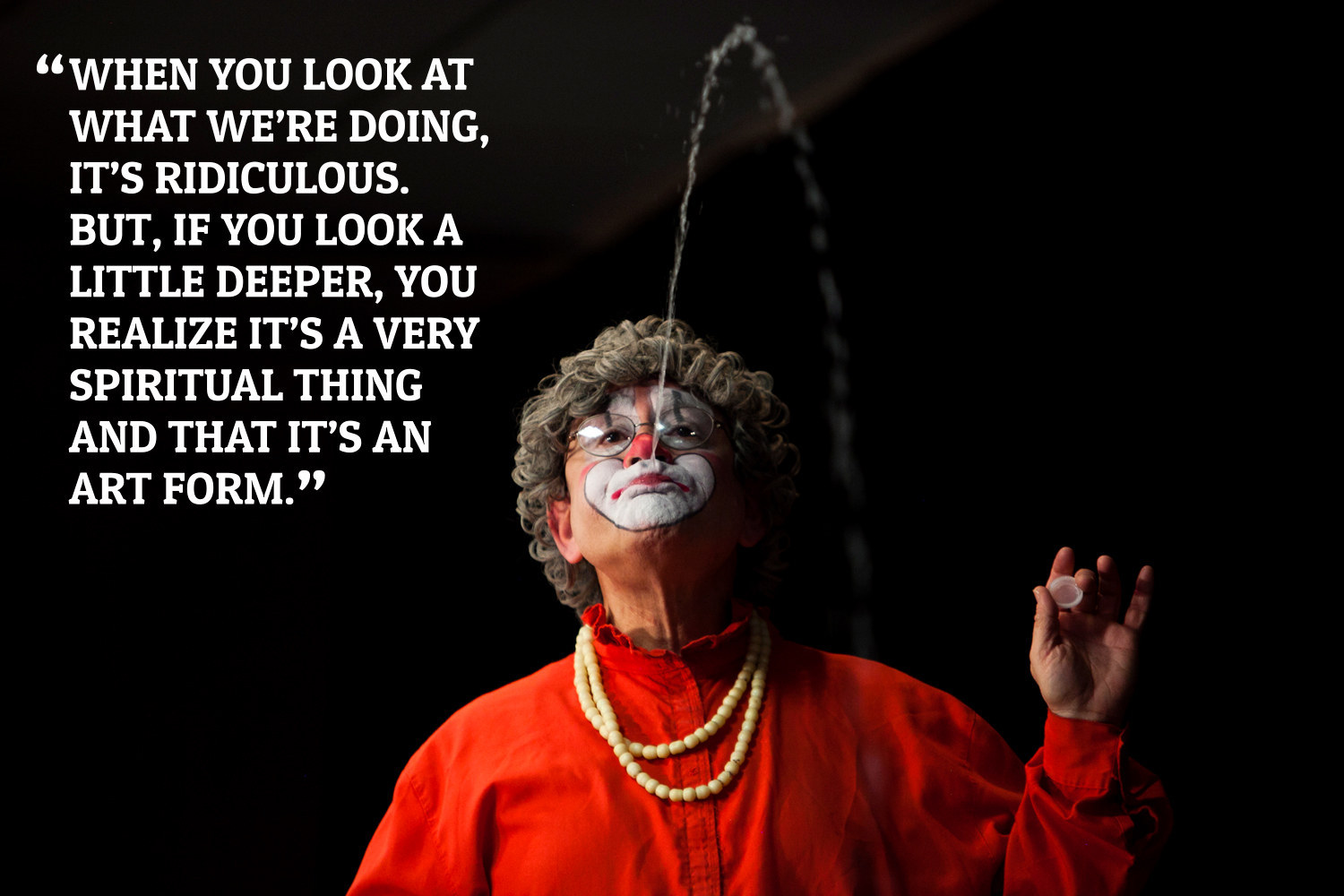
The next day I meet Lubin amid the hip-high stone walls and faux greenery of the hotel lobby, immersed in a steady stream of costumed clowns. He nestles right against the outer perimeter of my personal space, standing near me with the posture and spacing of a true New Yorker. He smiles. He is a small, sturdy man, squarish and curiously toned the way veteran stage performers are wont to be. As Grandma, he's patient, warm, and maternal; as Barry, he has an arid quality to him, his sound with the kind of hollow delivery that allows people to believe he is joking when they would like it to be so. He is bright, jaded, and generous with his insight, opening up about his life and feared inadequacies. Clowning, after all, is all about embracing failure.
When I ask about the shortage, he is quick to dismiss it. “It's completely fabricated, written by a person who doesn't know any better.” Useless tabloid drivel, nothing to see here.
He's currently working on his memoir, Tall Tales of a Short Clown (to be published “on Barnesandnoble.com and Amazon.com, which are the two, you know, biggies”). "I've been sober for almost 27 years and I skimmed over it in my original book," he says. "That's the shit people have to read. They have to know that.'”
The book, he tells me, covers his tales of performing globally and rubbing elbows with the stars. “My favorite chapter is ‘Celebrities I’ve Pissed Off,’ ‘cause I’ve pissed off a lot of celebrities.” (Those named include Meryl Streep, Bruce Springsteen, Ringo Starr, and — his favorite — Gene Kelly, but Lubin is wisely stingy about those details in deference to future book sales.) But the book also delves into Lubin's struggles with addiction, depression, cancer, and sobriety. “I think people are going to expect a funny book,” he confides. “But it’s not particularly funny. There’s funny in it, but it’s not a funny story.”
Lubin’s eyes visibly water when I ask about hospital clowning. “That's the most powerful thing you can do with your skill and knowledge.” He shifts in his chair. “I've performed solo for 20,000 people, and that's really incredible and exciting, but when you can make a small person in a hospital bed feel better? That's spectacularly powerful stuff.” He notes that people are quick to denigrate clowning, to downplay it as a weird, useless thing, wishing to correct the assumption.
“When you look at what we're doing, it's ridiculous. But, if you look a little deeper, you realize it's a very spiritual thing and that it's an art form.” He coughs defensively again at the phrase 'art form,' citing Charlie Chaplin's quote about the circus being the lowest art form. “My feeling is, at least it's an art form."
Soon, a body materializes out of nowhere, inches from Lubin’s face — a convention attendee. Skipping formalities, she launches into a monologue about her special trick that she doesn't show just anyone, a trick she saves for rare occasions. However, since she is such a big fan of his, and he is just so special, she is going to show him. Lubin stands there like a cat in the path of an affectionate toddler, declining politely as she sticks the tip of a long, pink balloon in her mouth. Enough air in the pink tube and she resumes twittering away, twisting two finger-length chunks of inflated latex to lie side by side and tying the shriveled, flaccid ends of the balloon together before stepping yet closer still to Lubin, placing the pink swollen lips over his mouth, and stretching the band around his head. Clasping her hands on either side of his head in robust affection, she presses her mouth on his with firm, familiar, unmistakable urgency before releasing him.
Lubin gingerly removes his stunt mouth and thanks his now swooning fan, the corners of his mouth pressed together and turning down in a muscular frown. She is oblivious and elated.
At the well-worn banquet-style folding table, Lubin’s demeanor has shifted from one of dread to one of quiet resignation. He drops his balloon gift on the table with a sigh and stares at the pink, shriveled umbilici, crumpled on the table like ripe, biological evidence. He grimaces into a shrug. “If she’s happy, I’m happy.”
Things seem to have been going well for Lubin these days. His cancer is in remission, his girlfriend's recent book was successfully published, he’s currently touring the U.S. doing some clown shows and seeing his kids. But there's still this edginess in him, like he’s waiting for someone to jump out and tell him things are going to turn south again, or he’ll wake up to find that maybe things never really changed at all. I almost want to offer to see if he’d rather talk while we pace one of the hotel’s oddly lit hotel hallways, as if perhaps the motion might calm him.
Yesterday during his writing workshop, one of the participants had raised her hand to ask a question and unloaded a lengthy, warbling soliloquy about clowns being a symbol of the "eternal survivor" on account of their "always getting up." Lubin responded with a cursory shrug, her failed attempt at an inspirational speech lingering in the air like a fart. "Yeah... That's a lot." He paused for a minute before remarking that clowns can be symbols of courage, sure, but they can also be symbols of nothing at all. "When I do a headstand on a Whoopee cushion, I'm not doing any of that."
He has big, soulful eyes and creases from a lifetime of concerned demeanor; when he talks about new research that says there's an increased statistical likelihood that his cancer could resurge, his face clouds with worry. It's a worn trope, the incredible clown who is sad inside, so obvious that it almost seems like a bit unto itself.
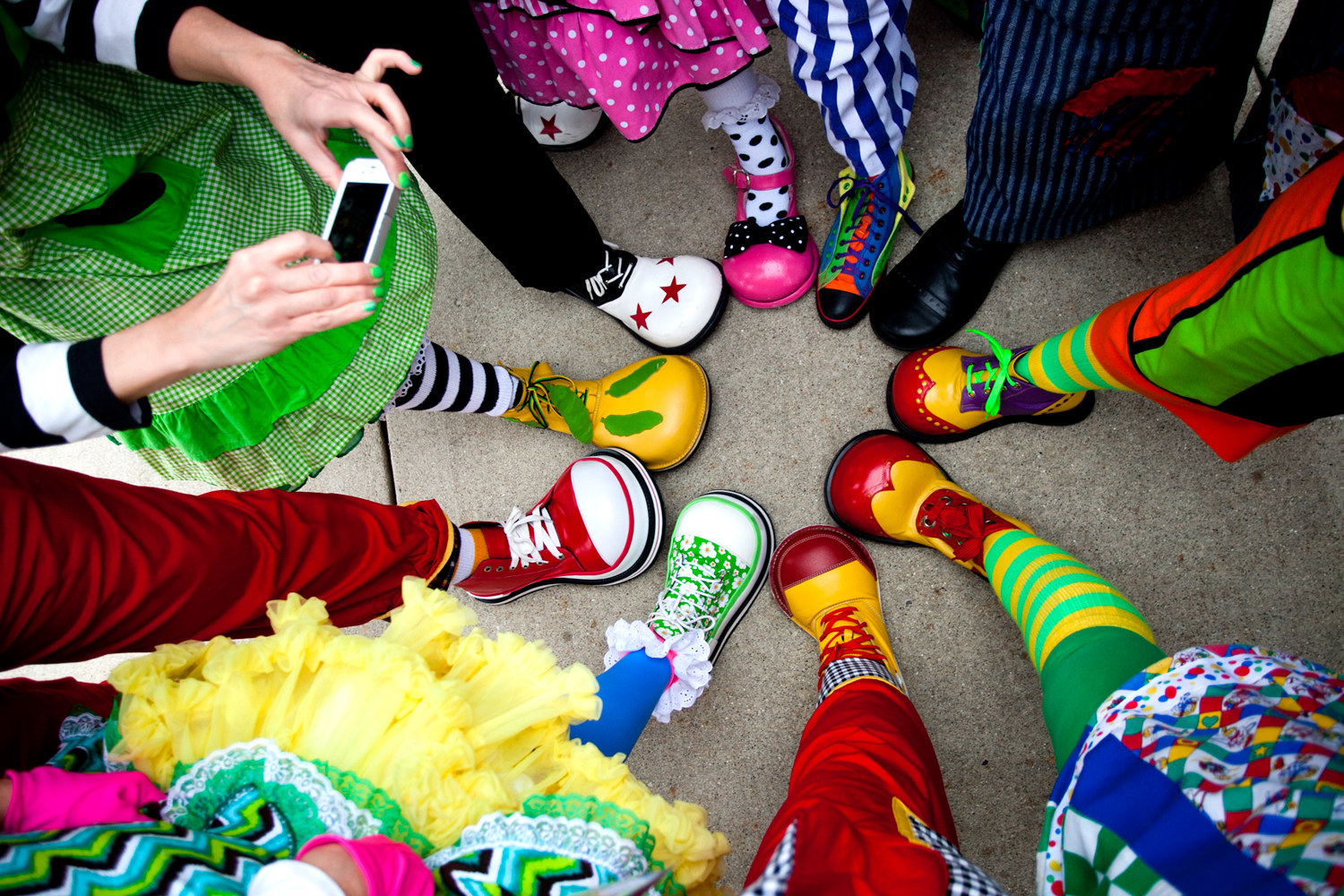
Consider Joseph Grimaldi, the creator of whiteface clown makeup and widely considered the father of modern clowning. His new look was a game changer in the early 1800s, and Grimaldi was arguably the most popular entertainer of his day. Eighteen months after Grimaldi married the love of his life in 1799, both she and their unborn child died in childbirth. When, to cope with his grief, he took to performing twice a night for audiences, he accidentally shot himself in the foot on stage. As he healed, he fell for Mary, a local dancer his mother hired to care for him, who he then married, who would later nearly bankrupt him with her extravagant spending. They had one son together who, after taking up clowning and performing with his father, shunned the family and died a destitute alcoholic at the age of 30.
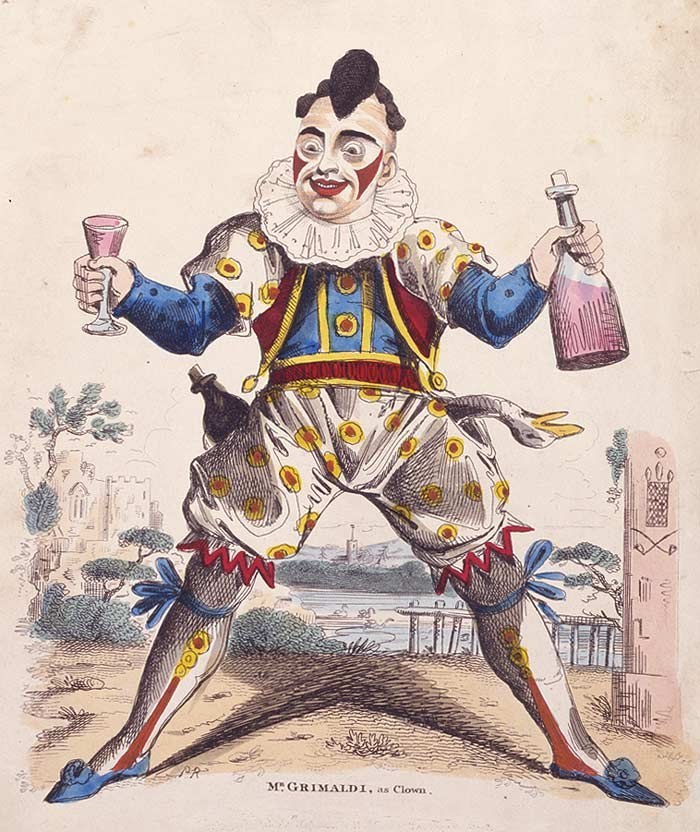
What does it say about humor that the achievement for which Grimaldi is best known, one of the most important theatrical designs of the 1800s, his creation of the whiteface clown, debuted only two years after the tragic loss of his wife and children?
Funny is a fine line to walk, in part because it’s such a necessary part of how we cope. According to Quinn Bauriedel, a respected cultivator of the next generation of clowns, the clown is “very related to tragedy because if you don't laugh at someone's suffering then you cry.”
The obvious example is America’s Funniest Home Videos, wherein families submit clips of khaki-clad dads getting kicked in the balls, or Uncle Dave falling off the roof, in the hopes of winning money by making people laugh. It’s essentially pure clowning, all physical comedy and pathos, save for the fact that the clown in the video was unaware of his role in the show.
Maybe less obvious is the brilliant, searing comedy of Maria Bamford, whose recent stand-up special involved her performing exacting impersonations of her parents for an audience of two: her parents. In their living room. It should be excruciating to watch, given her parents' obvious discomfort and the serious subject matter of Bamford’s mental illness, but instead — in true clown fashion — Bamford gives us something that resonates with the audience to inspire not sadness, but camaraderie. We see ourselves in her because she’s honest with us; and when she pokes those vulnerable bits, the tender ones we share with her, she mutates something painful and private into public and funny. “It's a very thin, sharp edge between one and the other,” says Bauriedel.
There’s more to clowning than emotional catharsis. Clowning, an art that spans cultures and geography alike, is part of the messy experience of being human, which means dealing not only with emotions, but also with limits.
“I think part of what’s essential about that comedy,” says Jaron Aviv Hollander, the former Cirque clown, “is this sense that sense of ‘What are the rules? What are the boundaries? And how can I get away with breaking them?'”
He goes on: “I think in some ways the great scientists and the great thinkers — the ones who really changed things — had to have a clown quality in them. Albert Einstein said, 'Here’s the universe as we think it is, and here’s this thing that looks totally different, so maybe the universe is wrong.' And that’s a clown way of thinking. And he changed all the rules.”
Toward the end of what turned into a two-hour conversation, Barry Lubin cocks his head and starts to study me again. “You know, you’re a very gentle reporter,” he tells me, softly smiling and looking at my eyes. He mumbles something about my not trying to provoke him or be controversial, and I respond something fumbling about how I’m just trying to do my job and not hurt people.
He laughs in a way that makes me think he understands exactly what I mean to imply: Telling the truth is always lose-lose. Spruce things up with a rose-tinted filter and clever narrative cuts, and the result is misleading fiction. Too honest, and those in the mirror’s path can become hostile, wounded by their own reflection. It’s hard to think of a better mirror for humanity than the clown, or a better soul for the clown than a sad one. In the words of the late, great Elaine Stritch: “You can’t be funny unless you are tragic, and you can’t be tragic unless you are funny.”
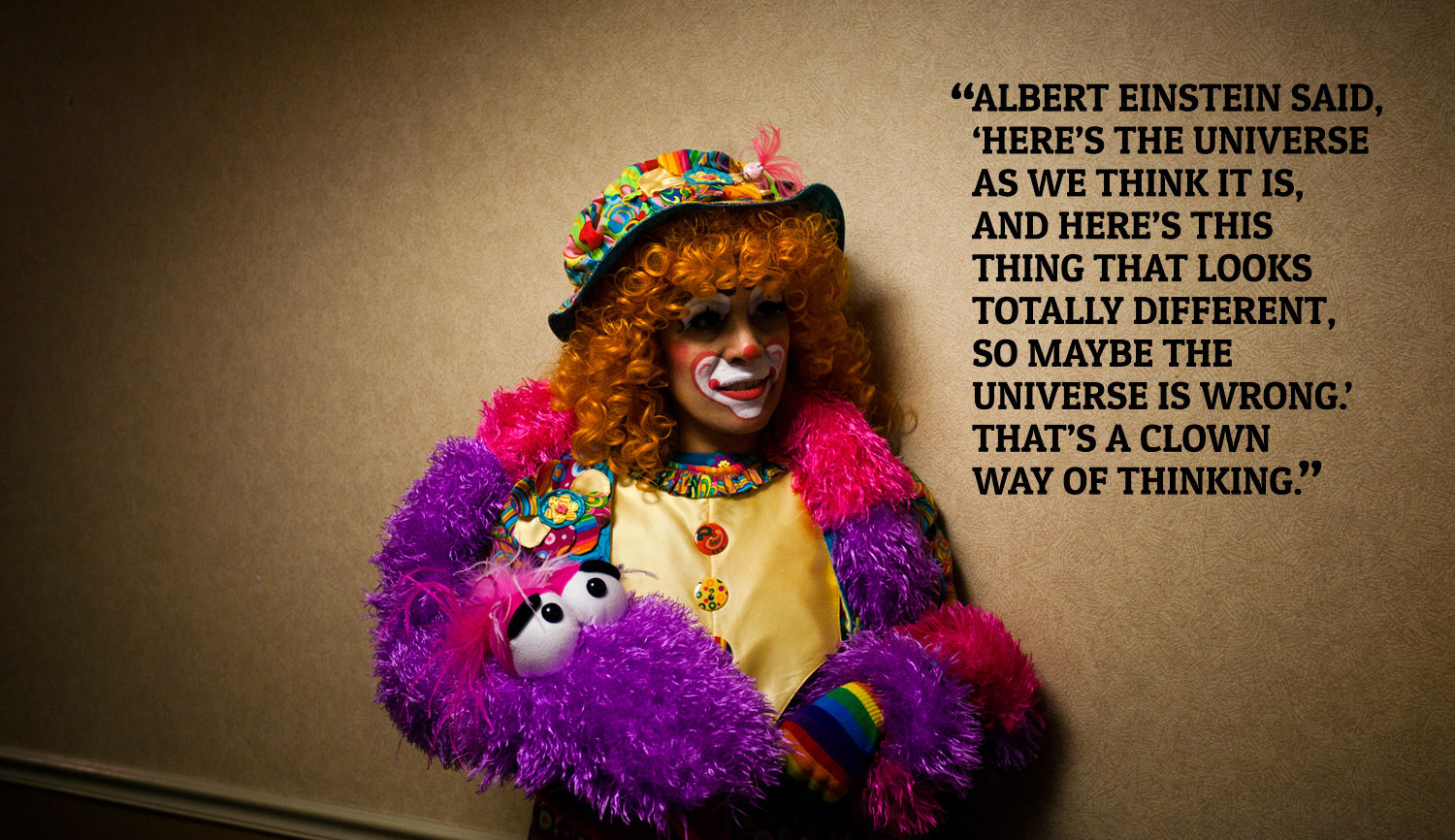
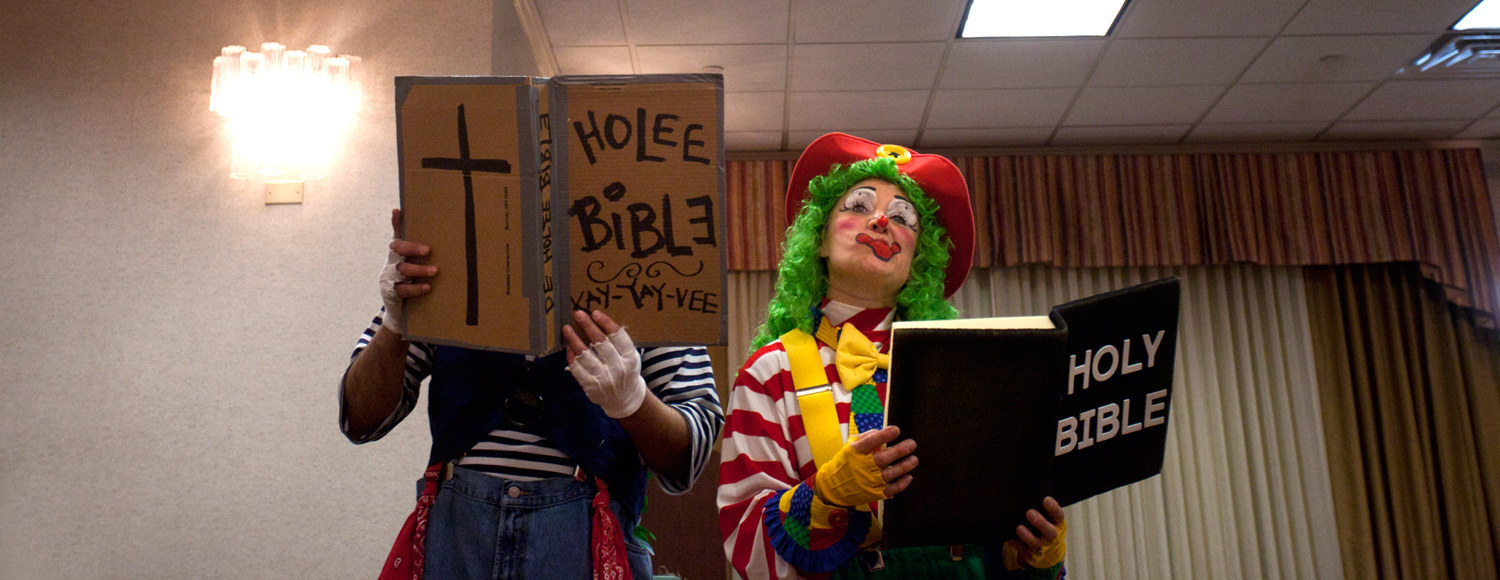
The gospel clowns of the World Clown Association, those who like to use their clowning to promote their faith, meet on the final morning of the weeklong convention for a little worship service, which apparently includes a soft boppin’ Jazzercise break, joke Bibles, and two performers leading the show in their full circus drag.
“The wages for the payment of sin is death,” the female clown barks while holding an enormous heart with the word “SIN” on it, complete with lots of glitter. The other clown is named Paco and is the clear crowd favorite. He is perhaps most delicately described as a kind Mexican Al Jolson who is pretending to be severely developmentally disabled as entertainment for a church service. Dressed in a George Selby cough-syrup nightmare version of Tijuana hobo-chic, Paco pulls pieces of ripped cardboard out of a bag. Each piece has a word written on it (though, spoiler, most of them are not in English or Spanish). This is his showstopping bit, the climax of the church service. When complete, the pieces say:
“YEESOOS LUBSM3
DESS EYE-NO 4
de BIBO TELS ME
SEW
BEELON
GWEEK
BUG HE ESS
STRON”
He loudly fumbles through the narration of “Jesus Loves Me” with the excruciating diction of a Mexican henchman in a racist old cartoon. His big “in” with the crowd appears to be his repetitious and saccharine apologies for his stupidity. When he’s finished his rendition of the Christian children’s classic, he turns over the sheet of duct-taped cardboard to reveal a portrait of Jesus Christ himself, drawn in the tender style of a melodramatic boardwalk caricature. With this, Paco drops his vaudevillian brownface act and opens his hunched, apologetic posture. Widening into a royal stance and unleashing a big, salty baritone, Paco stands before the room and — eyes closed — sings the song as it was intended to be heard, his straining, operatic voice circulating around a room of tearful Christians.
Afterward, a throng of people gathers to take cell phone pictures of his cardboard prop.
Seated on the gritty carpet near the back of the room, I make repeated and prolonged accidental eye contact with a German shepherd assistance dog curled into a spiral and gnawing on huge mouthfuls of her flank, which leads to a growing, matted darkness, and the sound of her chewing mixes with the squeals of women fawning over sweet Paco. I email my editor:
“I have never felt so certain about not only the absence of god, but in the complete, farcical meaninglessness of the whole universe.”
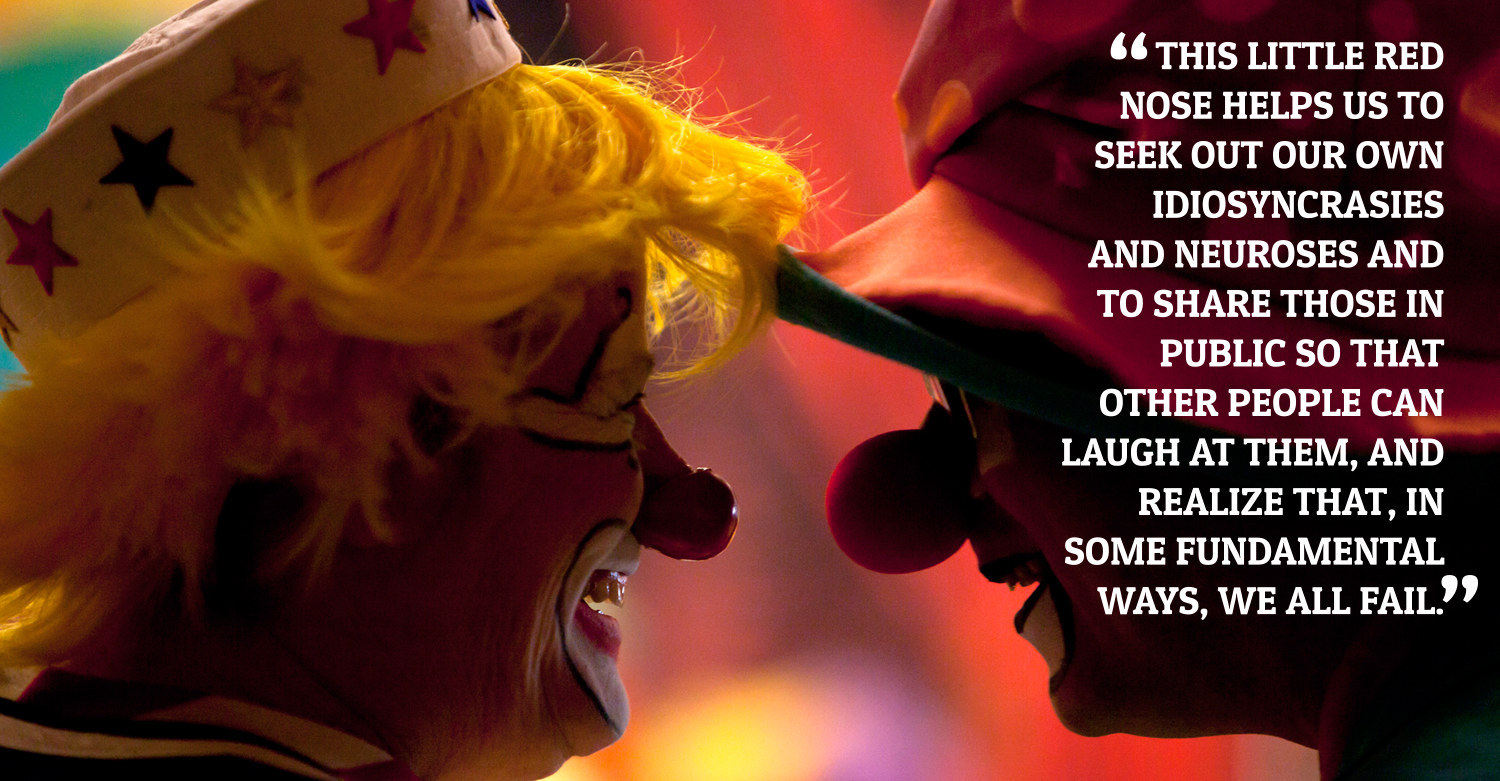
But I didn't come here to laugh; I came here to observe clowns in their natural habitat. As a natural coping mechanism for dealing with the side effects of staying so straitlaced while surrounded by such inescapable weird, the idle side conversations I’d been having with a photographer named Mando have gotten interesting pretty quickly.
“Mando, did you hear about the guy who shit his pants in a radio booth?”
He has not.
Apparently, a radio sports DJ in the Chicagoland area shit his pants in the booth and then fled the scene. The people coming in after him were, apparently, greeted by the carnage. I know this because the affected radio station was running poop discussions on-air while I was eating an oily egg-and-cheese sandwich in the O’Hare airport.
Over my breakfast, I was struck by the internal conflict that no doubt occurs when a soul is faced with the prospect of complete humiliation versus the insistence of its own animal body. A drama unfolds, a battle waged between mind and bowel, a struggle for dominion that was never really uncertain in the first place, a digestive Kobayashi Maru.
“But you know,” Mando begins after appearing to carefully consider the prospect, “he must have felt so much better for a second after it happened.”
We begin to consider this: The minutes clenched, the first foreshadowing rumbles, the taunting cramps, the last moments where hope felt possible and everything felt like it could turn out OK, the moment when what was foretold became the inevitable. There’s a harbinger, something bad happens, you fight until you can’t or won’t, and then there’s letting go. The profound sense of relief dear Radio DJ felt was likely fleeting. He tried his best and it was done. The tragedy — or humor — is that this relief was chased with what I can only imagine is a sense of ice-water panic, leading him to flee the scene. Abject horror mixed with carnal relief, it is decided.
We head up to the conference rooms to see what kind of clown action we can find. Halfway up the stairs, Mando, who is no more than a foot behind me, makes a noise. A very specific noise. And as soon as the sound hits my tympanic membrane, I know exactly what it is: the horrified whimper of relief that squeaked out of the DJ like an embarrassed death rattle when he shit his pants in the booth.
It feels like something is breaking inside me.
The first peal of laughter shoots from my throat like a solid object, slapping into the walls of the stairwell with an inappropriate amount of noise. I double over in apparent pain before shoving off from the walls of the landing and scurrying up the last flight of stairs like a roach with the lights on. I’m dimly aware of Mando behind me.
Outside the conference rooms at the top of the stairs, laughter is still shaking the shortest bones of my rib cage like a mosquito bite threatening to loudly itch anew if you so much as breathe on it. Navigating a hallway congested with clowns, I clench my jaw and summon the last vapors of my dignity. Though my hand is clasped over my nose and mouth, the smell here is disarming and impossible not to notice, with top notes of hotel carpet cleaner, mature-woman face lotion, greasepaint, and cotton candy (the base, unfortunately). Sucking air through the cracks in my fingers, I pick up hints of metabolized chardonnay; anxious body odor; stale cigarette smoke trapped in the sleeves of light jackets; an arts-and-crafts supply store; and the smothering, chemical aroma of a perfume worn sparingly since 1963.
Stumbling, obviously, my final few steps, I make it at last to the clearing at the end of the hallway, drop my hand, and suck in a fat lungful of this potent, dry air. The scent makes me cough. And that’s when it happens.
The first sound comes out like a howl, a wounded cat, a human siren. My knees buckle, brain replaying that perfect sound over and over. Deliberately pressing my spine into the wall, as if the sharpness of such pain might staunch a flood of this magnitude, my insides shake and churn without mercy. Mando is an arm’s length away, curled into the fetal position on the floor, his hands grasping between his legs and face contorted in pain. Tears are streaming down my cheeks and splattering salty, gray water on my glasses. I am certain there is mascara everywhere. I try to focus on sad things like dead people I’ve loved, and how much I miss my family when I’m traveling, and that one veterinarian who euthanized my kitten without letting me know, leaving her to die alone in a cage and stiffen to rigor before anyone had realized what had happened. Nothing works. In fact, thinking about all this only makes me laugh even harder. For the second time this weekend, I worry I will actually pee my pants.
By putting himself in the radio DJ’s shoes with such kindness and empathy, Mando had dreamed up a whimper of relief and terror so genuine, so horribly true, that the only response is to laugh. Because he wasn’t doing an impersonation of the DJ’s noise, not really; Mando made the noise as faithfully as he could, meaning he made the sound he himself would make in such a terrible situation. And that kind of honesty, in our culture of limits and rules and propriety, is at the very heart of clowning.
We’re all one bad meal away from involuntarily shitting our pants; we weren’t laughing at the DJ, we were laughing with him. Mando’s noise took something embarrassing and isolating and, in the act of sharing it, gave us moment of fleeting connection. Like popping a balloon, he destroyed the unspoken tension of being in such a strange environment, allowing me to forget — at least temporarily — all the detailed rules of conduct that kept us polite and engaged when the elevator doors opened to reveal a clown. Still struggling to catch my breath, curled prone on the generic hotel carpet, I’m so full of empathy for that man in the booth, so tender to his plight, that I have become completely, and publicly, unhinged. I feel high as a kite.
Surrounded by the many WCA members who are now pointedly ignoring us — the scornful, mocking media — I have never been so certain about the future of clowning. Because it’s more than just membership numbers in a trade organization, or performing inside a big top, or birthday parties, or mission trips, or hardcore fetish porn or wearing the greasepaint. The clown is, for better or worse, a part of us for the long haul. We try so hard and fail so spectacularly and take things so seriously, but when it comes down to it, we humans are brilliantly and poetically stupid.
The 2015 World Clown Association Annual Convention will be held in Reno, Nev.

